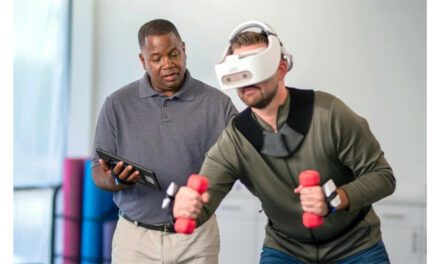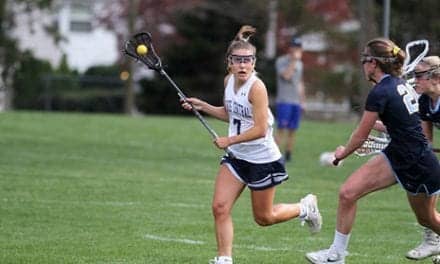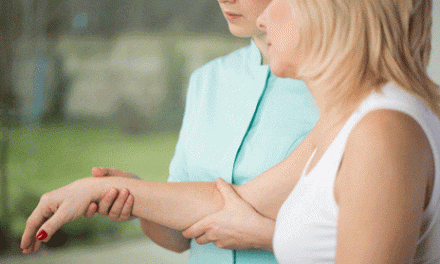Technologies that support patients and analyze activity data keep training sessions safe and productive.
By Corina Ponter, PT, MPT, NCS
Safety is something that is very important in any physical rehabilitation program. While reaching goals and getting results is always a priority for patients and therapists alike, being able to do so safely is of the utmost importance. In a rehabilitation setting, transferring patients, lifting patients, and responding to an unanticipated movement by a patient are the leading causes of injury for healthcare workers. Once a patient has fallen, the resulting anxiety, loss of confidence, or possible injuries can then further impede their progress toward their goals.
Technology for Gait and Balance Rehabilitation
With the world of physical therapy advancing rapidly, there have been many new technologies that have come into the market recently that have pushed gait and balance training further and made it easier for physical therapists and patients to safely and effectively work together. At TIRR Memorial Hermann inpatient hospital in Houston, we are able to help patients reach their rehab goals, while decreasing their fear of falling, by utilizing an individualized gait training program and taking advantage of various pieces of technology, such as the Vector Gait and Safety System from Valencia, Calif-based Bioness, Therastride body weight-supported treadmill system from St Louis-based Innoventor, and the GAITRite Gait Analysis system, offered by CIR Systems Inc, Sparta, NJ. In the TIRR Memorial Hermann outpatient facility, patients also have access to the Lokomat Locomotion system, from Hocoma Inc USA, Norwell, Mass.
Because every patient has different impairments, as well as different goals, our treatments need to be tailored to each individual patient, including our gait training. After completing a thorough evaluation of the patient, the physical therapist will determine the most optimal treatment plan to progress the patient toward their goals, and what, if any, technology could help the patient reach their gait goals more quickly.
Prevent Falls and Prevent Fear
One of the most frequently utilized pieces of equipment at TIRR Memorial Hermann inpatient hospital is the Vector Gait and Safety System from Bioness Inc, based in Valencia, Calif. The Vector allows us to train our patients in overground gait, balance, and a variety of other functional activities, such as picking up objects from the floor, crawling, practicing fall recovery, etc. The System consists of an overhead robotic trolley, a wireless software interface, and a conductive rail.
During the therapy session, the patient is connected to the Vector via a harness that is attached to the robot on the ceiling-mounted, zero-footprint rail. The robotic trolley receives commands from the software and automatically responds based on patient movement, or it can be manually operated by the therapist. Using a wireless control, therapists are able to easily adjust parameters such as body weight support and fall protection settings, depending on individual patient needs or the requirements for a specific activity. The data collected during a session can be analyzed by the therapists, and sessions can then be compared in order to capture objective progress that the patient has made.
By utilizing the Vector, staff members have been able to get patients up into standing and begin gait training significantly earlier than what was previously possible. The facility is now frequently able to use fewer staff members to stand and walk patients, and those staff members are usually able to walk the patients farther. For example, the patient who is able to walk 30 feet with the help of three people without the use of the Vector may now able to walk 75 feet with the assistance of two people and the Vector, allowing the patient to receive more repetitions in a safer setting.
The Vector system also allows the use of any other assistive device or technology that therapists may want to use for gait training, including something as simple as a cane or walker, or a more sophisticated technology such as the Bioness L300 Foot Drop System. The L300 is a functional electrical stimulation unit designed to treat foot drop, a condition that causes walking difficulty in adults and pediatrics affected by neurologic injuries.
Portable Walkway
In addition to the Vector System, we also use the GAITRite Gait Analysis system manufactured by CIR Systems Inc, Sparta, NJ, which features a portable electronic walkway that is connected to a computer to record timing and distance parameters for patients. As patients walk across the walkway, the GAITRite system sends data to the computer, documenting walking patterns, including step length and time. In turn, we are able to use this data to monitor improvements in the patient’s gait pattern and help us in determining appropriate additional interventions and treatment plans.
Treadmill Training
On the Therastride body weight-supported treadmill, a patient is harnessed and supported over the treadmill and provided with body weight support while ambulating. Members of the therapy staff provide as much or as little assistance as needed at the patient’s trunk, hips, and legs to enable the patient to walk in as normal of a gait pattern as possible. This technology, like the Vector, allows a patient to be up in standing and weight-bearing when otherwise it may not be possible due to the amount of assistance required. Patients are usually able to ambulate longer, and at faster speeds than can be achieved over ground. Immediately following a session on the Therastride, therapists try to ambulate the patient overground in order to carry over the training from the treadmill session.
Another device to which patients in the outpatient facility have access is the Lokomat Locomotion. This device is a robotic gait orthosis that automates locomotion therapy on a treadmill and works to improve the efficiency of treadmill training. Lokomat allows for highly intensive, individualized training in a motivational environment of constant feedback.
Tailored Rehabilitation and Technology for Successful Patient Outcomes
These gait training technologies can assist patients in meeting their individual goals for their physical rehabilitation, hopefully while eliminating the fear of falling or losing their balance. In addition, utilizing these technologies in our gait training offers patients tailored training while also keeping physical therapists from getting injured as well.
Corina Ponter, PT, MPT, NCS, is a 2002 graduate of Emory University in Atlanta. She has worked at The Institute for Rehabilitation and Research (TIRR) on the Brain Injury and Stroke Team since 2004 and is currently the physical therapy clinical coordinator for the team. In 2008, she received her Neuro-Integrative Functional Rehabilitation and Habilitation (Neuro-IFRAH) certification for treatment of adults with hemiplegia from a stroke or brain injury, and received her Neurological Certified Specialization (NCS) in 2011. She has participated in outpatient spasticity clinic, does ongoing program development, and mentors physical therapy staff members. For more information, contact [email protected].





